Finney was the first person other than Satoshi Nakamoto to contribute to the Bitcoin code and run a Bitcoin node. Finney was the first recipient of Bitcoin (sent by Satoshi himself).
Finney invented the concept of reusable proof of work, on which Bitcoin mining is based.
Satoshi communicated extensively with Finney long before Bitcoin was released. In one of their last blog posts, Satoshi publicly expressed his respect for Finney.
Not surprisingly, Finney is one of the most popular candidates for Satoshi, even though this means Finney faked a lot of his email interactions with Satoshi and contributed to Bitcoin under both his real name and another fake identity. Finney would continue to work on Bitcoin after Satoshi "left" in 2011.
V.Mail Forwarders
Len and Finney had a very rare and relevant skill: they were both developers of the mail forwarder technology that was a precursor to Bitcoin.
Invented by David Chaum along with cryptocurrency, mail forwarders are specialized servers used to send messages anonymously or pseudonymously. Their use was very common when contributing to the Cypherpunk mailing list, which itself was built on distributed mail forwarders.
Early mail forwarders simply forwarded messages while hiding the identity of the sender, while later protocols (such as Mixmaster, the most popular mail forwarder) relied on decentralized nodes to distribute fixed-size encrypted blocks of information across a P2P network. Bitcoin's architecture is very similar to that of a mail forwarder, although its nodes transmit transaction data instead of messages. In 1997, crypto-anarchist founder Tim May even proposed a digital currency based on mail forwarding programs.
As the lead developer, node operator, and lead maintainer of Mixmaster, Len is a prominent expert on mail forwarding technology. He has also implemented similar technology as a systems engineer and security architect at Anonymizer Privacy Guard.
Mail forwarding is not only a direct technical precursor to Bitcoin, but also the foundation of Bitcoin's intellectual history. In the article "Why Mail Forwarding Is Needed", Finney argues that mail forwarding is the foundation of an anonymous digital economy.
Mail forwarding represents the "underlying idea" of this concept, the ability to exchange information privately without revealing one's true identity. In this way, we can conduct transactions, show credentials, and reach transactions without government or corporate databases tracking our every move. One of the visions of the cypherpunks includes the ability to conduct transactions anonymously using "digital cash"... This is another area where anonymous mail plays an important role.
Mail forwarding operators were the first to recognize the need for cryptocurrencies: without an anonymous means of payment, mail forwarding had to be run out of the operator’s own pocket. This created scalability issues, and meant that spam and abuse were a persistent problem. Because of this, the underlying concepts of many cryptocurrencies stem from the need for an abuse-resistant, for-profit mail forwarding system:
In 1994, Finney proposed that mail forwarding could be monetized through anonymous “coins” and “cash tokens”.
Smart contracts were first discussed in the context of preventing mail forwarding abuse. Nick Szabo published a prescient paper on smart contracts in 1997, specifically mentioning Mixmaster.
Ian Goldberg and Ryan Lackey (Len knew both of them) were important figures in the mail forwarding community, and they participated in the development of an unfinished cryptocurrency called HINDE in 1998. Ian later created several early ecash clients, and Ryan became the CSO of Tezos.
So, Satoshi's second article on Bitcoin stated that sending emails for a fee was the first working use case of Bitcoin.
Initially it could be used for proof-of-work applications that were almost free but not quite free services.
It can already be used to send emails for a fee. The send dialog is resizable and you can enter a message of any length.
Six,Adam Back
One person who crossed paths with Len in the small mail forwarding community was Adam Back, CEO of Blockstream, who was the first person to communicate with Satoshi Nakamoto.
Back's interest in cryptocurrency began while operating mail forwarders, and he created the HashCash proof-of-work system for mail forwarder operators to combat spam and DDOS attacks. Satoshi Nakamoto later used HashCash as the basis for Bitcoin mining.
We know that Len worked directly with Back, listing him as a contributor to research papers and Mixmaster memos. Both were involved in many OpenPGP implementations and were connected in each other's PGP trust network.
Interestingly, Back himself has suggested that Satoshi may have been a mail forwarder developer, noting that developers would "practice their own techniques" to participate anonymously in cryptographic protocol discussions. Unlike many of the Cypherpunks discussed, we know that Len made a lot of anonymous contributions to the Cypherpunk mailing list through mail forwarders.
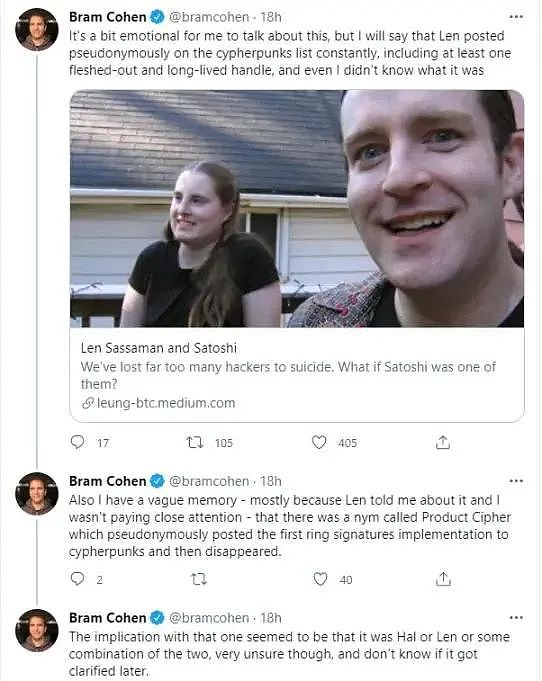
Bram Cohen's response to this article suggests that he and Hal Finney may have collaborated under pseudonyms
Seventh,Chaum and COSIC
After graduating from high school, Len worked to support his family and never had the opportunity to go to college. Despite this, in 2004 he landed his "dream job" as a researcher and PhD student at COSIC, a research group in computer security and industrial cryptography at the Catholic University of Leuven in Belgium.
Len's PhD advisor at COSIC was none other than David Chaum, the "father of digital currency." While Chaum laid the foundation for the entire cypherpunk movement and all cryptocurrencies, few can say they have worked directly with him.
Some of Chaum's relevant accomplishments:
His invention of cryptocurrency in his 1983 paper "Blind Signatures for Untraceable Payments."
The invention of the blockchain, where his 1982 paper detailed the code for all but one element of the blockchain, which are detailed in the Bitcoin white paper.
His company Digicash created the first electronic cash system. Anonymous payments between digital pseudonyms were central to this vision.
“[Chaum] was at the center of a seemingly unstoppable movement — the digitization of money… The wild card in the age of digital money is anonymity, and David Chaum believed that without it, we’re in trouble.”
While Digicash failed (in part due to its reliance on a centralized system), Chaum wanted to create a second digital currency that would offer a combination of anonymity and utility.
While many viewed its failure as proof that digital cash was unworkable, Satoshi defended “old Chaumian money” while acknowledging the problems posed by centralization.
Many people automatically assume that electronic money is doomed to fail because so many companies have failed since the 1990s. I hope everyone understands that it is the centralized controlled nature of these systems that dooms them to failure.
VIII. Len's Research
Len worked at COSIC in Belgium until his death in 2011. During this time, he published 45 publications and held 20 conference committee positions.
Len's research focused on developing privacy-enhancing protocols with "practical applicability" and working code. His main project (assisted by Bram Cohen) was Pynchon Gate, an evolution of mail forwarder technology that allows anonymous information retrieval through a distributed network of nodes without the need for a trusted third party.
This work is closely related to Bitcoin - as the work on Pynchon Gate progressed, Len became increasingly focused on finding solutions to Byzantine faults (aka the Byzantine Generals' Problem), which had been a major obstacle to early P2P networks.
In the context of distributed computing, Byzantine fault tolerance refers to the ability of a network to remain functional when nodes are compromised or unreliable. Byzantine fault tolerance is one of the biggest problems that needs to be solved for a secure, decentralized cryptocurrency without the need for double spending or trusted third parties. Satoshi Nakamoto's most important innovation was the "triple entry" accounting system, which solved this problem using the blockchain introduced by Chaum.
During the development of Bitcoin from 2008 to 2010, Len became increasingly active in the field of financial cryptography. He joined the International Association for Financial Cryptography and gave presentations at and served on committees at conferences on financial cryptography and data. The latter was founded by Robert Hettinga, an early and prominent advocate of digital cash, which was a major topic at the conference.
Ninth,Satoshi as an Academic
Numerous clues indicate that Satoshi worked in academia during the development of Bitcoin, an idea shared by Gavin Andersen, founder of the Bitcoin Foundation.
“I think he was an academic, maybe a postdoc, maybe a professor, who just didn’t want to attract attention.”
Nakamoto’s code contributions and comments increased dramatically during the summer and winter vacations, but gradually decreased in the late spring and year end, when academics had final exams or grades.
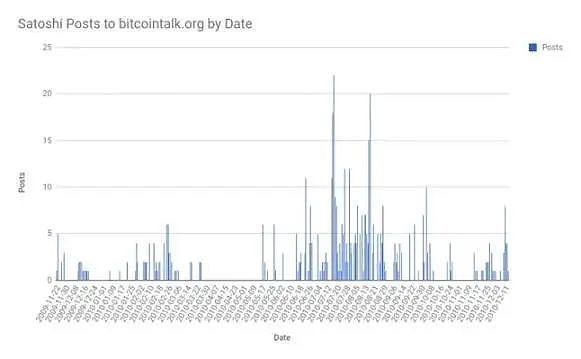
The unique construction of Bitcoin’s code also suggests that Satoshi had an academic background. Bitcoin has been described as “brilliant but careless,” eschewing traditional software development practices like unit testing, but exhibiting a cutting-edge security architecture and an expert understanding of academic cryptography and economics.
Whoever did it had a deep understanding of cryptography… they’d read academic papers, they had a sharp intellect, and they’d combined these concepts in a truly new way.
When Dan Kaminsky, a well-known security researcher, first reviewed Satoshi’s code, he tried to penetrate it with nine different vulnerabilities, but was surprised to find that Satoshi had anticipated and patched them all.
"I thought of some beautiful bugs, but every time I looked at the code I found a line of code that would solve the problem... I've never seen anything like it."
This may indicate that Satoshi Nakamoto and Kaminsky had common information security experience and expertise. Coincidentally, Len and Kaminsky co-authored and published a paper showing methods to attack public key infrastructure.
In addition, the Bitcoin white paper was published in a form rarely seen on the Cypherpunk mailing list - a LaTeX-formatted research paper with academic content such as an abstract, conclusion, and MLA citations. In contrast, other proposals such as Bitgold and b-money are unstructured blog posts.
10.Satoshi Nakamoto in Europe
Since COSIC is headquartered in Leuven, Len lived in Belgium during the development of Bitcoin. This is important because many facts indicate that Satoshi lived in Europe — a major focus of the New Yorker’s early investigations.
Satoshi’s writing style reflects British English spelling and word choices, such as bloody hard, flat, maths, grey, and the dd/mm/yyyy date format. However, Satoshi also mentions the euro instead of the pound.
Bitcoin’s genesis block also contains the headline of that day’s edition of The Times (“Chancellor on brink of second bailout for banks”). The headline is unique to the print edition, which is only distributed in the UK and Europe. In 2009, The Times was one of the top ten newspapers in Belgium and was “widely used by scholars and researchers because of its wide circulation in libraries and its detailed indexing.”

These clues leave us with a paradox: they suggest that Satoshi Nakamoto was European, but the person who possessed the necessary skills and understood the main implications of Bitcoin was most likely American. Most of the cypherpunk community held joint conferences and meetups, which is one reason why there is a disproportionate number of people from the United States, especially San Francisco. Similarly, jobs that allow access to cutting-edge professional information security and cryptography experience are concentrated in the United States.
Oddly, despite being American, Len uses exactly the same British English as Satoshi Nakamoto.
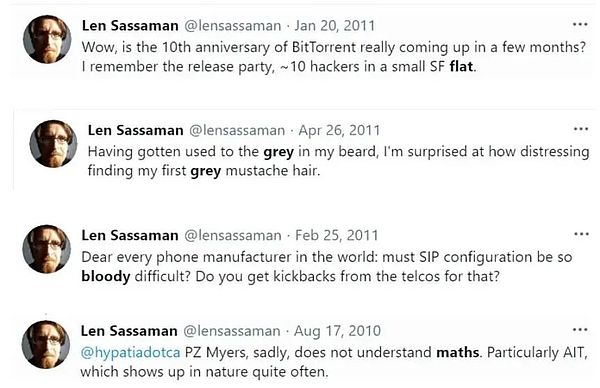
Analyzing Satoshi’s posting history, we can find that he is a European “night owl” who works on Bitcoin after get off work or school during the day. Satoshi also said that the increase in mining difficulty happened “yesterday”, but if he lived in the United States, that would be a different story.
Assuming that Satoshi lived a life unrelated to Bitcoin, he was not working at his computer at home most of the time during work or school… If Satoshi lived in the BST time zone, he worked most of the time at night, often until the early morning
When we checked Len’s tweet history, we found that the timestamps of Satoshi’s posts and code submissions matched Len’s own late-night activity very well.
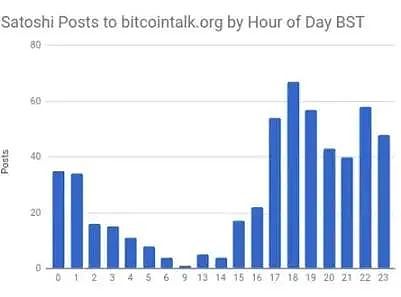
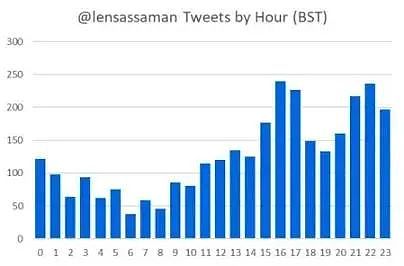
11.P2P Network
Although Bitcoin is not the first cryptocurrency, it is the first cryptocurrency based on a fully P2P distributed network. Satoshi Nakamoto emphasized the importance of this when he first mentioned Bitcoin:
I have been studying a new type of electronic cash system that is completely peer-to-peer and does not require a trusted third party.
Dan Kaminsky said that in order to create Bitcoin, Satoshi needed to "understand economics, cryptography, and P2P networks," and Len had an unusually early and in-depth understanding of all three disciplines and their applications to digital currencies.
While in San Francisco, Len lived and worked with Bram Cohen, the creator of BitTorrent, the most widely used P2P protocol. During this time (2000-2002), Bram developed a revolutionary P2P network called MojoNation, which used the "Mojo Token" digital currency, making it one of the first publicly issued digital currencies.
In MojoNation's P2P economy, "tokens" can be used to exchange file storage, which will be encrypted and encoded into "blocks" uploaded to a distributed network of nodes hosting a public ledger, which is reminiscent of Bitcoin's own distributed bilateral accounting system. Mojo was not just an internal accounting token, but a full currency — it was redeemable for USD and vice versa. Some of the early discussions about token economics involved the mechanics of the Mojo token.
One Mojo unit represents a portion of the current functionality of the entire system. If you work for me now, I will give you tokens, and in the future when the network is larger, these tokens will represent a portion of a larger pie, so their value will increase as you spend them.
Satoshi discussed token economics in a very similar way:
It has the potential to form a positive feedback loop; as more users are added, the value will also rise, which can attract more users to take advantage of the growing value.
Although visionary, MojoNation’s economic model soon collapsed due to hyperinflation. Satoshi consciously designed Bitcoin to avoid this fate by having deflation built in and not relying on a central “coinage” server.
In 2001, Bram launched BitTorrent. As a P2P alternative to centralized Napster, BitTorrent foreshadowed Bitcoin’s own distributed node topology and consensus system, as well as a protocol-level incentive system. BitTorrent not only innovated on networks like Gnutella at a technical level, but also leveraged economic incentives and game theory.
Len presciently told Bram that “BitTorrent will make him greater than [Napster founder] Sean Fanning.” Satoshi later mentioned Napster when explaining the need for a fully decentralized web.
Governments are good at cutting off the leadership of centrally controlled networks like Napster, but pure P2P networks like Gnutella and Tor seem to be able to hold their own.
Coincidentally, Len and Tor founder Roger Dingledine both worked on the development of the Mixminion mail forwarding protocol, spoke together at the Black Hat conference, and co-founded the HotPETS conference.
In 2002, Len and Bram co-founded the CodeCon conference, which focuses on "highly practical projects with useful code." At CodeCon in 2005, Finney introduced reusable proof-of-work via a modified BitTorrent client that sent P2P digital currency. One commentator described it as:
... the world's first transparent server that facilitates a distributed, collaborative world of RPOW servers.
Digital currencies were a hot topic at the inaugural CodeCon, which included a HashCash demo by Adam Back and Zooko’s introduction of Mnet, the fully open-source and decentralized successor to MojoNation. Mojo is not affiliated with any one company and can be independently audited, both of which Satoshi considered critical.
MojoNation co-founders Zooko Wilcox and Jim McCoy also became inspirations for Bitcoin and cryptocurrency pioneers. Zooko was one of Satoshi’s first collaborators and an employee of David Chaum at Digicash, and Satoshi included a link to Zooko’s blog when Bitcoin v0.1 was released on Bitcoin.org. Zooko later founded Zcash, a major privacy-focused cryptocurrency. He created the often-discussed “Zooko’s Triangle” framework.
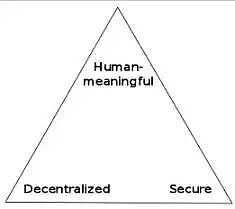
"The Zooko Triangle is a trilemma of three properties that the names of network protocol participants are often considered to have"
McCoy is also a major influencer in the cryptocurrency space, and Ryan Selkis of Digital Currency Group has said he believes McCoy may be Satoshi.
12.Hacktivism
Even by the standards of the cypherpunk community, both Len and Satoshi had particularly strong ideological beliefs and a commitment to open knowledge.
I wish you wouldn’t talk about me all the time… maybe talk about open source projects and give more credit to your development contributors
Satoshi’s “hacktivist” approach to distributing Bitcoin through free open source grassroots projects stands in stark contrast to their predecessors. Chaum, Stefan Brand, eCash, and others took a very different approach: filing patents, forming closed source venture capital firms, and trying to drive adoption through corporate partnerships.
This is similar to Len’s extensive contributions to open source projects like PGP, Mixmaster, GNU Privacy Guard, and his extensive volunteer experience in groups like the Shmoo Group.
Satoshi hinted at their ideological leanings several times, saying Bitcoin was “very attractive to libertarian views” and could “win a major battle in the arms race and gain a new free territory in a few years.”
Len is equally passionate about defending open knowledge and technological progress from interference from corporations and governments.
The pursuit of knowledge is a fundamental part of being human. Any form of prior restriction is, in my opinion, an infringement on our freedom of thought and consciousness. Therefore, not only do I want us to avoid overly restrictive knee-jerk legislation… I don’t want to see anyone build a framework that could be misused for that purpose.
ThirteenEnd
Just as Satoshi Nakamoto created Bitcoin under a pseudonym, Len was in a sense forced to live under his role. After an accident in 2006, Len’s non-epileptic seizures and functional neurological problems became increasingly severe, which exacerbated the depression he had been fighting since his youth.
A victim of stigma, Len “felt like he had to continue to maintain the illusion of being this super-capable guy” and was “terrified” that his declining health would end his work and disappoint the people he cared about.
Despite these challenges, Len continued to work until a few months before his death, contributing to papers and even giving a talk at Dartmouth. Tragically, he successfully hid the severity of his situation from almost everyone in his life.
Few people knew the extent of it… One phrase I heard repeatedly was “We never knew, it looked like he was doing fine.”
As Len built on the ideas that had come before him, one sensed that he was committed to building something that would outlast him, which is one of the reasons for his commitment to open source and open knowledge.
This is our legacy, our research and ideas, which will lead to knowledge that humans have never had the opportunity to obtain in history, and which we will pass on to future generations. We need to make sure that we don't get stuck in a situation where we can't share our research with others, and that it doesn't get locked away in the vaults of intellectual property lawyers.
Len's death in 2011 was a huge loss for the cypherpunks and the entire tech community, a fact reflected in the outpouring of memories and sympathy that followed. One comment stood out to me: an article posted by "pablos08" on Hacker News.
Len and I became friends, and we were both cypherpunks in those wild times. We reimagined our world, a world filled with cryptographic systems that would mathematically enforce the freedoms we cherished. Anonymous mail forwarders would protect speech from retaliation; onion routers would ensure that no one could censor the Internet; digital cash would enable a completely free economy. We plan to decentralize and distribute everything. We envision complex and esoteric threats to future problems — and we design future protocols to defend against those threats. All of this is geeky utopian academic exercise. I tend to keep it that way, but Len wants to get his hands dirty.
Cypherpunks write code.
 JinseFinance
JinseFinance











